6 Rail Transportation
Ashley Abel
6.1 Introduction
Keywords
- Tramway Locomotive – A steam locomotive that is specially designed, or modified, to run on a street, or roadside, tramway track
- Steam Locomotive – A locomotive using as motive power steam that is usually self-generated in the locomotive’s own boiler by the combustion of fuel (such as coal or oil)
- Subway – A railway system that is used to transport people in urban and suburban areas underground
- Freight Train – A train that is used to transport products and goods
- Passenger Train – A train that people use for traveling
- Maglev Train – A train that is supported by either electromagnetic attraction or repulsion
- Bullet Train – A high-speed passenger train
Learning Objectives
By the end of this chapter students should be able to:
- Understand the importance of rail transportation, specifically trains
- Describe the role of trains had on society
- Discuss past and present innovations made in the transportation industry
- Illustrate the future of rail transportation
Of the different modes of transportation, rail transportation and its innovations have greatly improved the way of life. Before modern trains, rail transportation was just wheelbarrows or carts on railroad tracks. But we have come a long way from that to these powerful machines that can go at different speeds and give us relaxing rides. Additionally, trains are not just used for transportation. They are used for the shipment of goods which include: cars, produce, weapons, animals, etc. This multi-use gives trains an important part of society. Without them, life as we know today would be different.
6.2 Origins of Trains
Key Takeaway
In this section, we will discuss the origins of rail transportation and the modern train.
The first recorded history of rail transportation was in Ancient Greece. The Greeks did this by creating grooves in limestone roads and using wheeled vehicles on them. This technology was then lost due to the Romans conquering the Greeks until the 16th century where wooden rails were put in roads and horse-drawn wagons were driven on them. During the 1770’s, wooden rails were switched to iron rails and the wheels of wagons were grooved allowing a better grip to the track. This design was an important feature that was later incorporated into locomotive designs.
The first steam tramway locomotive was seen in 1804. It was funded by Samuel Homfray who then commissioned the project to Richard Trevithick. It was able to haul 10 tons of iron, 70 men and five extra wagons in 9 miles. The trip took two hours to complete. Then in 1814, George Stephenson, an English inventor and colliery engineer, built the first steam engine locomotive. During the 1820’s, Julius Griffiths, an Englishman, was able to patent the first passenger steam locomotive and Stephenson’s locomotives were being used for both goods and passenger travel. The trains were able to pull six loaded coal cars and 21 passenger cars filled up to 450 passengers. Later on in 1829, Stephenson innovated the steam locomotive to where the second design became the standard of which steam engines would be built for about 150 years.

“George Stephenson 1781-1848.” is in the Public_domain
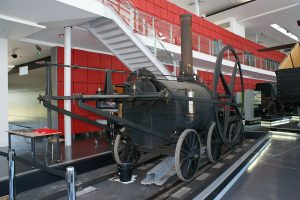
“Richard Trevithick 1804 Pen y Darren locomotive” is licensed under CC BY-SA 2.0
6.3 Types of Trains
Key Takeaway
In this section, we will discuss the impacts of the five most common trains used in society, how they work and their uses.
There are many types of train used in day-to-day life. There are subways, freight trains, passenger trains, maglev trains and bullet trains. Each type of train is a fundamental part of society that we could not live without.
6.3.1 Subway
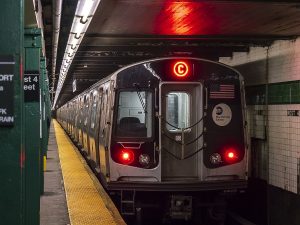
“R179 C train at West 4th Street.jpg” is licensed under CC BY-SA 4.0
A subway, or underground, tube and metro, is a railway system that is used to transport people in urban and suburban areas underground. A common place that we all know of having a subway is New York. In New York, the subway is a more efficient way of transportation. It helps people take shortcuts and get to their destination faster. With how heavily congregated New York is, buses and cars are not the best means of transportation.
A subway is controlled by a remote control, or joystick, and a control panel. Acceleration and braking are done through the joystick and buttons on the control panel. There are no foot pedals. There is usually only one crew member per train in case of train failure. It runs on three railroad tracks. The third railroad track provides power through an exposed electrical line. The other two tracks guide its direction.
6.3.2 Freight Train
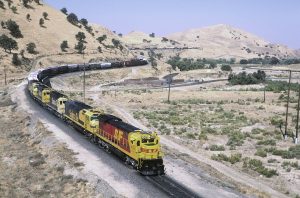
“ATSF Downhhill Caliente Aug 90xRP” by Drew Jacksich is licensed under CC BY 2.0
A freight train, or cargo train, is a train that is used to transport products and goods. It is one of the most efficient, largest and safest ways goods are transported in the United States. It is very beneficial to both the producers and consumers. One American requires the movement of approximately 54 tons of freight per year. The goods that are transported are most likely to be bulk components, like equipment, construction materials, metals, foods, etc. Modern freight trains are an average of 73 cars where in the late 1920’s, the average length of a freight train was 48 cars.
6.3.3 Passenger Train
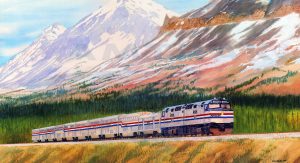
“TRAIN E USA AMTRAK ‘EMPIRE BUILDER’ PASSENGER TRAIN” by Gil Reid is in the Public Domain
A passenger train is a train that people use for traveling. The only passenger train in the United States is Amtrak. Amtrak is a corporation that strives to deliver high quality, safe, on-time rail passenger service. They have been in business since October 30, 1970.
6.3.4 Maglev Train
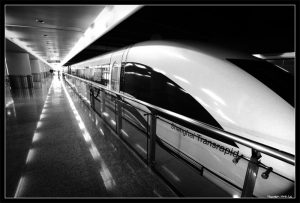
“Shanghai Maglev Train” by Discopalace is licensed under CC BY-NC-ND 2.0
A maglev train is a train that is supported by either electromagnetic attraction or repulsion. There are two sets of magnets: one set is to repel and push the train up off the track and the other set is to propel the train forward. Instead of a normal railroad track, a maglev train uses a T-shaped rail. It allows for the electromagnetic field to pull the train at breakneck speeds. Since there are no wheels, the ride is essentially smoother. The train is controlled by computer monitors that regulate the strength of the electromagnetic field to keep the train elevated and the direction of the electromagnetic field for stopping at train stations.
6.3.5 Bullet Train
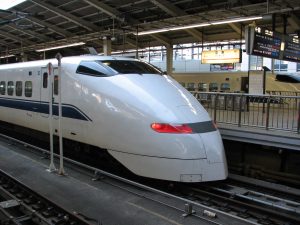
“Bullet Train” by Daniel Foster is licensed under CC BY-NC-SA 2.0
A bullet train, or referred to as a high-speed rail, is a high-speed passenger train. Bullet Trains are more commonly used in Europe and Asia. There are none in the United States. It is more common in those countries due to the high density population and close proximity to cities and countries. These trains provide quick travel in highly congested areas. The trains work by just improving the application of standard trains. By just improving the computer system, changing breaks to conserve energy, incorporating aerodynamic designs and so much more, the trains are able to go out at high speeds that regular trains are not able to reach.
6.4 Trains in the Military
Key Takeaway
In this section, we will discuss how the military used trains as an advantage in wars.
In war, any technology that is used correctly can give an advantage to either side. In the American Civil War, a key player that paved the way for victory for the Union was trains. Trains were able to move soldiers, weapons and food in a decent amount of time to where the Union was replenished faster than the Confederate. In World War I, train cars were even equipped with artillery. The train cars would have railroad heavy guns that could provide a destructive force. The dense amount of railroad tracks provided great mobility and allowed railcars to move from multiple positions quickly. The trains would also have an ammunition car that was able to provide a multitude of weapons on the front lines.
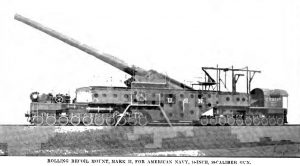
“US 14 inch 50 cal railway gun Mk II.jpg” is in the Public Domain
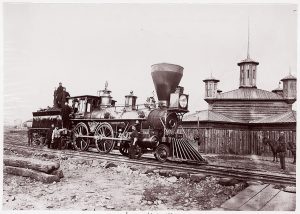
“Locomotive -133, U.S.M.R.R. MET DP70475.jpg” is in the Public Domain, CC0
6.5 Impacts of Trains
Key Takeaway
In this section, we will discuss the advantages and disadvantages of trains on society.
Advantages
There are many advantages that rail transportation gives us. Trains are able to move faster and with less interruption, especially when it comes to weather and road conditions. Large or bulk quantities of product are easier to transport by rail since it is more cost-effective, especially for long distances. Trains are even good for long distance travel for people. It is cost-efficient in high density countries such as China, Japan, India, etc. It is a good source of income to the country due to tourism. Having trains readily available for tourists brings a huge profit to countries. It also connects countries together and brings them closer to each other.
Disadvantages
But there are also disadvantages to rail transportation. For shipping of goods, rail is only good for bulk items and long distances. Short distances are not as cost-effective. Plus, trains have to stick to a rigid schedule. If broken off of its schedule, the delay could be a large amount of time (around 2-5 days). Trains have to stick to rigid regulations that could limit what can be transported. Also, railway infrastructure costs a significant amount of money that could lead to monopolies if there is no competition.
6.6 Rail Transportation in the Future
Key Takeaway
In this section, we will discuss how trains will be in the future and how society will use them.
The future of rail transportation is leading more towards high speed trains, subway and freight trains. High speed trains will bring faster speed between short and long distances. It will even cut down on gas emissions that will hurt the environment due to it relying on electricity instead of diesel. Subways will be more efficient and allow a better alternative than cars and trucks. With cities growing more and more, subways are a better option to invest in to help the environment. Freight trains will be more energy saving way of transporting goods then the other modes of transportation. Plus it also gives the advantage of being cost efficient. Rail transportation will lead to a better world that we can be proud to live in.
Case Study: Abraham Lincoln’s Funeral Train
On April 25, 1865, a black train containing the coffin of Abraham Lincoln went on a two week journey before heading to the burial site in his hometown of Springfield, Illinois. The train went to 180 cities and seven states so American can pay their respects to the president. The train cars used on this journey were made by George Pullman. They were luxurious sleeping cars made for high comfort. The featured polished black walnut interiors, chandeliers and marble washstands and made overnight travel much more enticing for passengers. After the burial of the president, there was an uptake of Pullman train cars.
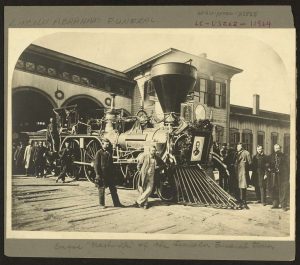
“Engine “Nashville” of the Lincoln funeral train” is in the Public Domain, CC0
6.7 Chapter Summary
Overall, rail transportation is an important aspect of life that we don’t think about too often. It reaches many circles of society that brings us one step closer to greatness. Freight trains make it possible for long distance transportation to be cost-effective. Subway trains make urban transportation a hassle free life. Bullet trains bring speed but also efficiency to a new level that is not seen a lot. Maglev trains make long rides a smoother transition than its usual roughness. Regular passenger trains provide an easy alternative to soak up the countryside and other sites when vacationing. All these aspects of rail transportation are leading us into a future that is bright and technologically advanced.
1. Who was credited for the first steam locomotive engine for railways?
A. George Stephenson
B. Samuel Homfray
C. Richard Trevithick
D. Julius Griffiths
2. What type of train is run only underground
A. Maglev
B. Passenger
C. Bullet
D. Subway
3. Which side of the American Civil War did trains help?
A. Union
B. Confederate
4. True or False. The first recorded sighting of rail transportation was in Mesopotamia?
A. True
B. False
Answers
- A
- D
- A
- B
Food For Thought
- Is the age of rail going to come to an end?
- Are trains a better source of transportation than automobiles?
References
About Amtrak. Amtrak. (n.d.). Retrieved November 23, 2021, from https://www.amtrak.com/about-amtrak.html.
Advantages and Disadvantages of Rail Transportation. Navata. (2021, July 30). Retrieved November 24, 2021, from http://www.navata.com/cms/advantages-and-disadvantages-of-rail-transportation/.
Bellis, Mary. (2020, August 27). The History of Railroad Technology. Retrieved from https://www.thoughtco.com/history-of-railroad-4059935
Britannica, T. Editors of Encyclopaedia (2021, August 5). subway. Encyclopedia Britannica. https://www.britannica.com/technology/subway
Drenning, E. (2002). FAST TRACK FOR TRAINS. ASEE Prism, 11(5), 32–33. http://www.jstor.org/stable/24160419
Freight rail overview. Freight Rail Overview | FRA. (n.d.). Retrieved November 18, 2021, from https://railroads.dot.gov/rail-network-development/freight-rail-overview.
Historic timeline. Amtrak. (n.d.). Retrieved November 23, 2021, from https://history.amtrak.com/amtraks-history/historic-timeline.
IEA (2019), The Future of Rail, IEA, Paris https://www.iea.org/reports/the-future-of-rail
Klein, C. (2017, May 12). 10 trains that changed the world. History.com. Retrieved November 24, 2021, from https://www.history.com/news/10-trains-that-changed-the-world.
Lepage, J. G. (2017). Military Trains and Railways: An Illustrated History. United States: McFarland, Incorporated, Publishers.https://www.google.com/books/edition/Military_Trains_and_Railways/V34yDwAAQBAJ?q=&g bpv=0#f=false
Levinson, David. 1990. Rail Reinvented. A Brief Summary of High Speed Ground Transportation. CiteSeerX. (n.d.). https://citeseerx.ist.psu.edu/viewdoc/download?doi=10.1.1.219.2341&rep=rep1&type=pdf
A steam locomotive that is specially designed, or modified, to run on a street, or roadside, tramway track.
A locomotive using as motive power steam that is usually self-generated in the locomotive’s own boiler by the combustion of fuel (such as coal or oil).
A railway system that is used to transport people in urban and suburban areas underground.
A train that is used to transport products and goods.
A train that people use for traveling.
A train that is supported by either electromagnetic attraction or repulsion.
A high-speed passenger train.

